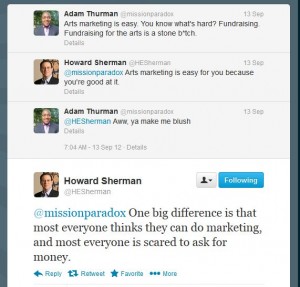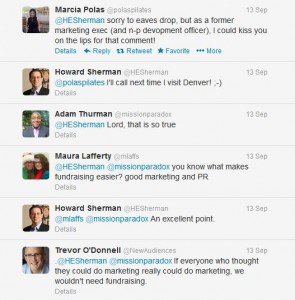Recently, (though it could have been 6 months ago the way time flies for me) Howard Sherman pointed back to a Huffington Post entry he did a few years ago about how the theater community looks derisively upon community theater.
I don’t know that this will ever change. But I recently got to thinking in the context of the Pro-Am trend where people are making greater efforts to hone their skills and knowledge, should community theaters be pushed to do and expect more to serve the needs of Pro-Ams and improve their own proficiencies?
Even though this proposal may see funding diverted away from larger established organizations (which has actually been suggested often in any case), in the long term it may benefit the arts in general.
Now that I am back living in a rural setting, I drive past volunteer firehouses regularly. It got me to thinking, not only are these firemen volunteering to run into burning buildings, they have to undergo 50-100 hours of training, refresher training, maintain good physical condition and show up to a certain percentage of calls to qualify for the privilege of risking their lives.
Not to mention mundane maintenance, housekeeping and fund raising duties.
I started wondering if maybe there needed to be a bit of a cultural shift for community theater groups toward requiring people to take classes and training in order to participate. I know there are many organizations that are pretty substantial and offer classes, but most come together on a project by project basis and don’t engage in a larger education effort.
Those who work backstage have the best chance of gaining additional skills because they are often being taught by people with some sort of construction background. Still, often novices are integrated into the effort without much safety training in advance. And they can be limited to only learning the techniques the most experienced person knows if there isn’t any effort to bring in outside experts.
I think actors might suffer most if they are only involved on per project basis. They gain the experience of performing and can certainly advance. But since the director is responsible for guiding many people, there is really no opportunity to instruct actors about techniques and the process of experimenting and exploring one’s options.
Having classes can enhance the value of the organization overall. Teaching is an effective path to learning so even if the group handles the classes entirely internally, they end up a little better off than when they started.
Bringing in guest teachers for seminars, whether it is a person from the community theatre the next county over, a professor at the local college or a designer from the big city, is even more ideal. (And maybe the experience will cut down on the derision a little.)
Now you may think it an awful idea to require people to attend classes if they want to participate in a performance because it puts up a barrier to entry at a time when the arts are trying to be welcoming to all.
But I wonder if a lack of this sort of rigor has resulted in the attitude we are seeing today that artists shouldn’t want to be paid because they engaged in a fun activity. Taking a class won’t necessarily guarantee a person will become any more skillful, but they will be more aware of the dedication and investment involved.
I don’t think having a requirement that if you want to participate, you should want to get better, is that onerous.
The classes don’t even necessarily need to be separate from the rehearsal process, though only having them as part of the process is actually more elitist because the training is limited to those who are cast.
When you think about it, when sports teams practice they don’t arrive at the field and move to their assigned roles. There are a lot of drills that focus on the fundamental skills of the game, improving physical condition and endurance. Players are asked to perform outside of their accustomed roles. There are clinics occasionally given by skilled practitioners.
This happens at all levels of play because the expectation is that you will strive to be a better player at the end of the season than you were when you came to the first training session. People who aren’t willing to make that commitment get cut from the team.
So that is why I wonder what sort of results would we see if funding and influence were directed toward creating an environment where honing skills became the norm.
I have been thinking for 20 minutes of a way to say it without it sounding condescending without much luck, but this bringing influence to bear would of necessity include a culture shift which saw “professional groups” partnering with community groups to provide training and assistance. As I said, I don’t think there will ever be a time when community theater will be viewed with complete parity by professional groups, but the gap will never close without increased interaction.





I've been to a few of the Science on Tap events, though I never gave a talk at one of…